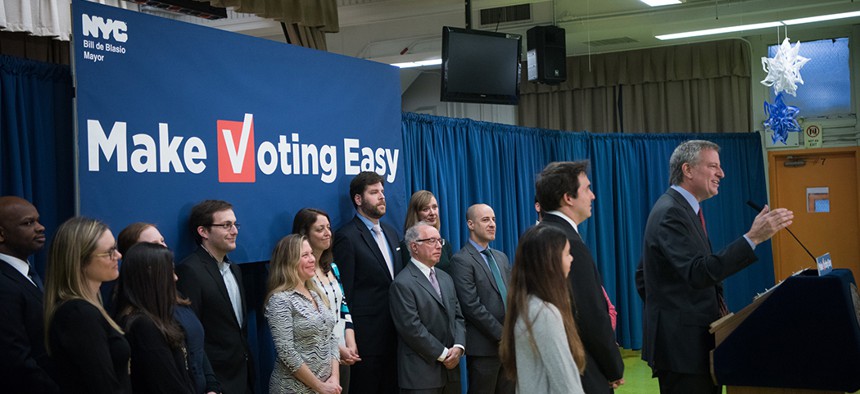Bill de Blasio
New York City should expand voting rights as part of charter revision
New York state keeps failing to ease voting, but New York City can do it on their own.

Mayor Bill de Blasio signs legislation to create a online voter registration system in December, 2017. Michael Appleton/Mayoral Photography Office
New York’s state Legislature is lagging behind the rest of the country when it comes to promoting democracy and making voting accessible to all eligible citizens. Thirty-seven states have early voting, allowing more opportunities to go to the polls for people who have trouble getting off of work or finding child care. Currently, New Yorkers are stuck with fixed hours on a Tuesday. Twelve states and the District of Columbia have automatic registration while New York has strict deadlines to register or change party enrollment. Twenty seven states and D.C. have no-excuse absentee voting, while New Yorkers must predict in advance if they will be out of town or too ill to vote.
Many states have open primaries, permitting voters to decide on the spot from which party candidates to choose. I don’t favor such open-ended procedures – party affiliation should be meaningful – but New Yorkers who want to change enrollment from one party to another must currently do it 25 days before the last year’s general election. That is a ridiculously long time. Voters should be able to change parties a month or two before the primaries.
Fifteen cities and the state of Maine use instant runoff voting, which eliminates a second trip to the polls to vote for the top two-vote getters. Although New York City has runoffs only for mayor, public advocate and comptroller, voters should be able to rank their choices on one ballot rather than have to make a second trip to the polls two weeks later and use taxpayer dollars for a second vote. If it works for the other cities (and, by the way, the Academy Awards), New Yorkers could learn how to do this fairly easily.
This year, the state Legislature has failed again to pass election reform, but cities and other local governments throughout New York state have a powerful tool at their disposal to make their own elections more democratic and user-friendly. For example, New York City’s Charter Revision Commission in 1988 enacted a campaign finance program that is the envy of the nation. The city also has term limits for city public officials and non-partisan voting for vacancy elections. A few years ago, a charter commission even lowered the number of petition signatures required to get on the ballot. And just a few months ago, Suffolk County enacted its own campaign finance reform – a program providing public matching for its elections.
New York City has the opportunity to take a giant step forward. It can institute early voting, enhanced registration, easier enrollment procedures and instant run-off for city elections. Once this dramatic set of election reforms are adopted by the commission, the voters would have a chance to weigh in. The new rules wouldn’t take effect until the next municipal election in 2021, so the Board of Elections would have three years to implement the changes.
So, as the state Legislature tries to figure out if it really wants election reform, New York City should grab the opportunity to expand voting opportunities through charter revision.
The mayor has already appointed a Charter Revision Commission, and I recently testified in support of these proposals. The City Council, having voted last month to create its own commission, is about to name its members, which will include appointees of every citywide and borough official – a broad-based group that would evaluate every aspect of the city charter. While this may seem a bit duplicative, it allows reformers two bites of the apple. Both will hold hearings, analyze the entire charter and make proposed changes to put on the ballot. The mayor’s commission is set to place charter reforms on the ballot this November. The Council’s commission will deliberate longer, and put amendments up for a vote in November 2019.
When I testified, the mayor’s commission appeared to give these pro-democracy reforms a serious hearing. If they don’t see fit to adopt them, however, I trust that the council’s commission will.
NEXT STORY: Free street parking in Manhattan is a rip-off

